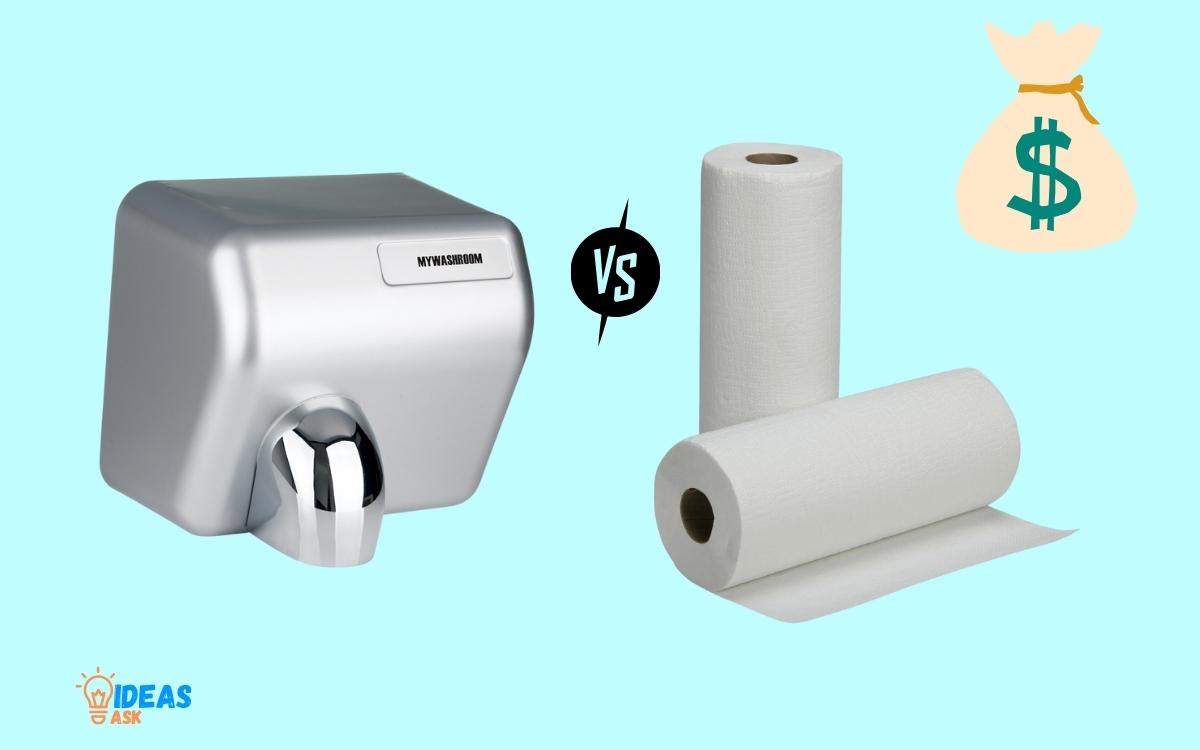Electric Hand Dryers Vs Paper Towels Cost: Discover!
When comparing the cost of electric hand dryers and paper towels, electric hand dryers tend to be more cost-effective in the long run.
Although the initial purchase and installation cost of an electric hand dryer can be higher, the ongoing costs are substantially lower than continually purchasing and replacing paper towels.
Electric hand dryers consume electricity, but the consumption is relatively low. Once installed, the only expenses are for electricity and occasional maintenance.
On the other hand, paper towels require constant replenishment which cumulatively can be quite expensive. Plus, there’s the added cost of waste disposal of used paper towels.
Although electric hand dryers may seem expensive at first glance, their long-term cost-effectiveness is what makes them a smart choice.
With the constant need for paper towel replenishment, disposal, and the environmental impact, the cost of using paper towels can add up over time. Therefore, switching to electric hand dryers is not only an economical but also a sustainable option.

Key Takeaway
Cost Comparison: Electric Hand Dryers Vs Paper Towels
| Aspect | Electric Hand Dryers | Paper Towels |
|---|---|---|
| Initial cost | High: Dryers can cost between 300to300 to 300to1500 each | Low: Dispensers cost approximately $50 each |
| Recurring cost | Low: Electricity cost is typically 0.02to0.02 to 0.02to0.04 per dry | High: Paper towel refills can cost 20to20 to 20to50 per pack |
| Maintenance cost | Low: Occasional maintenance and part replacement | High: Regular refilling and dispenser maintenance |
| Lifespan | Long: 7 to 10 years on average | Short: Depends on the usage frequency |
| Long-term cost effectiveness | High: Over their lifespan, dryers can result in substantial savings | Low: Ongoing cost of refills and maintenance can add up over time |
| Environmental cost | Lower: No waste produced, uses electricity | Higher: Potential waste, uses resources for production |
Cost Analysis: Electric Hand Dryers
Let’s break down the cost analysis for electric hand dryers into the specified categories:
Initial Installation Costs:
- Hand Dryer Unit: The cost of the hand dryer unit itself, which varies based on the brand, model, and features.
- Installation: Expenses related to installing the hand dryer, including electrical work, mounting, and any additional construction required.
Energy Consumption and Operational Expenses:
- Electricity Costs: The ongoing cost of electricity to operate the hand dryer. This depends on the dryer’s wattage, usage patterns, and local electricity rates.
- Usage Patterns: The frequency and duration of use impact operational expenses. High-traffic areas may have higher usage and, consequently, higher energy costs.
- Sensor Technology: Some hand dryers feature advanced sensors that optimize energy usage by activating the dryer only when hands are detected.
Maintenance and Repair Expenses:
- Routine Maintenance: Regular cleaning and maintenance to ensure the hand dryer operates efficiently. This may include filter replacement, sensor cleaning, and general upkeep.
- Repairs: Costs associated with unexpected breakdowns or malfunctions. Consider warranty coverage, if applicable, to mitigate repair expenses.
Long-term Cost Implications:
- Lifespan: The expected lifespan of the hand dryer influences long-term costs. Higher-quality, durable units may have a longer lifespan.
- Technology Advances: Consider the pace of technological advancements. Newer models may be more energy-efficient or have additional features that could impact long-term savings.
- Replacement Costs: If the hand dryer needs replacement due to obsolescence or wear and tear, factor in the cost of a new unit.
It’s essential to note that while electric hand dryers may have higher initial installation costs compared to paper towels, they can offer potential long-term savings due to reduced ongoing expenses for supplies.
However, this depends on factors such as energy efficiency, usage patterns, and maintenance practices.
To perform a comprehensive cost analysis, gather specific data on the selected hand dryer model, local utility rates, expected maintenance needs, and any warranties or service agreements.
This information will enable a more accurate assessment of the overall cost implications over the hand dryer’s lifecycle.
Cost Analysis: Paper Towels
Let’s break down the cost analysis for paper towels into the specified categories:
Initial Procurement Costs:
- Paper Towel Dispensers: The cost of purchasing and installing paper towel dispensers.
- Paper Towel Supply: The initial cost of procuring paper towel rolls or packs.
Environmental Impact Considerations:
- Paper Production: Consider the environmental impact of paper production, including deforestation and energy consumption.
- Transportation: Factor in the environmental costs associated with transporting paper towels to the facility.
- Waste Disposal: Consider the environmental impact of disposing of used paper towels, which may contribute to landfill waste.
Maintenance and Disposal Expenses:
- Restocking Costs: The ongoing expense of purchasing new paper towel supplies for restocking.
- Labor Costs: Expenses related to the labor required for restocking paper towels and addressing dispenser-related issues.
- Disposal Costs: If the facility incurs costs for waste disposal, this should be considered.
Long-term Cost Implications:
- Usage Patterns: The frequency and volume of paper towel usage impact long-term costs. High-traffic areas may require more frequent restocking.
- Dispenser Lifespan: The expected lifespan of paper towel dispensers may impact long-term costs. Durable, low-maintenance models may have lower total costs over time.
- Environmental Regulations: Anticipate potential future changes in environmental regulations that could affect the use and disposal of paper towels.
It’s important to note that while paper towels may have lower initial procurement costs compared to electric hand dryers, they come with ongoing expenses for supplies, maintenance, and disposal.
Additionally, there’s a growing emphasis on the environmental impact of paper production and waste, which may lead some facilities to consider more sustainable alternatives.
Comparative Cost Efficiency
Let’s compare the cost efficiency of electric hand dryers and paper towels by considering the following factors:
Direct Cost Comparison:
Electric Hand Dryers:
- Initial Procurement Cost (Unit + Installation)
- Electricity Consumption Cost
- Maintenance and Repairs Cost
Paper Towels:
Consideration of Usage Frequency and Traffic:
Electric Hand Dryers:
- Evaluate the usage patterns and frequency of hand dryer use in the facility.
- Consider the impact of high traffic on electricity consumption.
- Assess if the hand dryers can handle the demand during peak times.
Paper Towels:
Evaluation of Cost-Effectiveness Over Time:
Electric Hand Dryers:
- Assess the energy efficiency of hand dryers and potential long-term savings.
- Consider the expected lifespan of hand dryers and any warranty coverage.
- Factor in technological advancements that may improve energy efficiency.
Paper Towels:
Ultimately, the cost efficiency comparison should be tailored to the specific circumstances of the facility.
Environmental Factors
Ecological Impact:
Electric Hand Dryers:
- Positive Aspects: Hand dryers reduce the demand for paper production, helping to conserve forests. They also eliminate the need for transportation and disposal of paper towels, reducing associated carbon emissions.
- Concerns: The manufacturing and disposal of hand dryers contribute to their ecological footprint. Additionally, there are debates about the hygiene impact and potential airborne germ dispersion associated with hand dryers.
Paper Towels:
- Positive Aspects: Some paper towels are made from recycled materials, reducing the demand for new paper production. Biodegradable options may also be available, contributing to waste reduction.
- Concerns: The production of paper towels involves deforestation, energy consumption, and transportation. Disposal of used paper towels contributes to landfill waste unless proper recycling or composting practices are in place.
Cost Implications Related to Environmental Sustainability:
Electric Hand Dryers:
- Consider potential cost savings related to reduced paper production and transportation.
- Assess the environmental impact of manufacturing and disposing of electronic components in hand dryers.
- Evaluate the overall sustainability practices of the hand dryer manufacturer.
Paper Towels:
- Factor in potential costs associated with waste management and disposal of used paper towels.
- Consider the environmental cost of paper production and transportation.
- Assess any additional costs related to purchasing recycled or eco-friendly paper towel options.
Incorporating Long-term Environmental Costs:
Electric Hand Dryers:
- Consider the long-term environmental benefits of reduced paper consumption and waste.
- Assess the potential for technology advancements in hand dryers that improve energy efficiency.
- Evaluate the environmental impact over the expected lifespan of the hand dryers.
Paper Towels:
- Consider the long-term environmental costs of continued paper production and waste generation.
- Assess the potential for advancements in sustainable paper production or recycling practices.
- Anticipate any future regulatory changes related to environmental sustainability.
When conducting a comprehensive analysis, it’s crucial to weigh the environmental factors alongside direct costs.
Consider the lifecycle analysis of each option, including manufacturing, transportation, usage, and disposal.
Additionally, staying informed about evolving environmental standards and practices can help in making more informed decisions that align with sustainability goals.
User Experience and Hygiene
Factors Influencing User Satisfaction:
Electric Hand Dryers:
- Speed and Efficiency: Users often appreciate quick and efficient hand-drying, so the speed of electric hand dryers can influence satisfaction.
- Noise Level: Some users may find loud hand dryers disruptive or unpleasant, so quieter models are generally favored.
- Hygiene Features: Modern hand dryers may include features like HEPA filters to enhance cleanliness, contributing to user satisfaction.
Paper Towels:
- Texture and Quality: The feel and quality of paper towels can impact user satisfaction.
- Perceived Hygiene: Some users may feel that paper towels are more hygienic than hand dryers, contributing to overall satisfaction.
- Familiarity: Users who are accustomed to paper towels may prefer the familiar experience.
Connection Between Hygiene and Cost-Effectiveness:
Electric Hand Dryers:
- While concerns about airborne germ dispersion exist, studies suggest that properly designed and maintained hand dryers can be hygienic.
- Cost-effectiveness may be achieved by reducing the need for paper production, transportation, and waste disposal, which can contribute to environmental sustainability.
- Paper Towels:
- Paper towels are often perceived as more hygienic, as they physically remove moisture and bacteria from hands.
- However, the cost-effectiveness of paper towels may be compromised by ongoing expenses related to paper production, transportation, and waste management.
Consideration of User Behavior and Preferences:
Electric Hand Dryers:
- Some users appreciate the touchless and automated features of hand dryers, especially in light of hygiene concerns.
- Preferences may vary based on age groups, with younger generations often more accepting of modern hand dryer technology.
- Paper Towels:
- Users who prefer the tactile feel of paper towels or those concerned about hygiene may lean towards this option.
- Older generations may be more accustomed to and comfortable with paper towels.
Considering user behavior and preferences is essential for overall user satisfaction. Facilities should aim for a balance between providing a hygienic experience and meeting user expectations.
Balancing these factors with cost considerations and environmental impact will help in making a well-rounded decision that aligns with the needs and preferences of the user base while also addressing hygiene and cost-effectiveness concerns.
Conclusion
When comparing the costs of electric hand dryers and paper towels, it is evident that electric hand dryers offer a more cost-effective solution in the long run.
While paper towels may have a lower upfront cost, the ongoing expenses of purchasing and restocking them can add up over time.
Electric hand dryers, on the other hand, require only periodic maintenance and do not require additional expenses for supplies.
This makes electric hand dryers a more sustainable and economical choice. Moreover, electric hand dryers also offer environmental benefits.
With the increasing focus on sustainability, businesses and individuals are looking for ways to reduce their carbon footprint.
The use of electric hand dryers eliminates the need for paper towels, which not only saves trees but also reduces waste and energy consumption associated with their production and disposal.
The cost-effectiveness and environmental advantages make electric hand dryers a superior option compared to paper towels.
By investing in electric hand dryers, businesses can save money in the long term while also contributing to a greener and more sustainable future.






